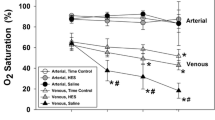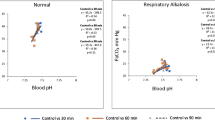Abstract
In patients with metabolic alkalosis, compensatory alveolar hypoventilation may induce hypercapnia and hypoxemia. In edematous or normallyhydrated patients without electrolyte deficiencies, acetazolamide — a carbonic anhydrase inhibitor — has been advocated to correct the primary acid-base disturbance, thereby preventing hypoxemia.
The hemodynamic consequences and the effect on oxyhemoglobin dissociation of acetazolamide, were studied. Twelve critically ill patients with metabolic alkalosis were given 15 mg/kg body wt. acetazolamide intravenously. Cardiovascular performance was completely unchanged. The P50 was 26.6 mm Hg at the beginning and the end of the study, indicating that hemoglobin-oxygen affinity is unaffected by acetazolamide.
In six patients, investigated after open-heart surgery, the arterial oxygen tension increased by 10–45%. This was probably related to the combinded effects of slight reductions in total body oxygen consumption or shunting of venous blood through the lungs.
Eight of the 12 patients were on controlled ventilation. After acetazolamide there was a mean increase in mixed venous carbon dioxide tension (P\(\bar v\)CO2) of 4.5 mm Hg, with no increase in arterial carbon dioxide tension (PaCO2), indicating only a limited interference with carbon dioxide uptake and release of the carbonic anhydrase inhibition. No other adverse reactions were observed.
Similar content being viewed by others
References
Bear R, Goldstein M, Phillipson E et al (1977) Effect of metabolic alkalosis on respiratory function in patients with chronic obstructive lung disease. Can Med Assoc J 117:900
Brunner FP, Frick PG (1968) Hypokalaemia, metabolic alkalosis, and hypernatraemia due to “massive” sodium penicillin therapy. Br Med J 4:550
Cain SM, Otis AB (1961) Carbon dioxide transport in anesthetized dogs during inhibition of carbonic anhydrase. J Appl Physiol 16:1023
Gallagher TJ (1979) Metabolic alkalosis complicating weaning from mechanical ventilation. South Med J 72:786
Goldring RM, Cannon PJ, Heinemann HO, Fishman AP (1968) Respiratory adjustment to chronic metabolic alkalosis in man. J Clin Invest 47:188
Goodman LS, Gilman A (1980) The pharmacological basis of therapeutics 6th edn. Macmillan Co, New York
Hodgkin JE, Soeprono FF, Chan DM (1980) Incidence of metabolic alkalemia in hospitalized patients. Crit Care Med 8:725
Jarboe TM, Penman RW, Luke RG (1972) Ventilatory failure due to metabolic alkalosis. Chest 61:61S
Lichtman MA, Murphy M, Pogal M (1976) The use of a single venous blood sample to assess oxygen binding to haemoglobin. Br J Haemat 32:89
Maren TH, Rayburn CS, Liddell NE (1976) Inhibition by anions of human red cell carbonic anhydrase B: Physiological and biochemical implications. Science 191:469
Miller PD, Berns AS (1977) Acute metabolic alkalosis perpetuating hypercarbia. A role for acetazolamide in chronic obstructive pulmonary disease. JAMA 238:2400
Rolf LL Jr, Garg LC (1975) The effect of acetazolamide and carbonic anhydrase inhibition on erythrocyte 2,3-diphosphoglycerate content and metabolism. J Pharmacol Exp Ther 193:639
Rooth G (1971) Acid-base and electrolyte balance, vol 1, Studentlitteratur, Lund, Sweden
Schwartz WB, van Ypersele de Strihou C, Kassirer JP (1968) Role of anions in metabolic alkalosis and potassium deficiency. N Engl J Med 279:630
Sutton JR, Houston CS, Mansell AL et al (1979) Effect of acetazolamide on hypoxemia during sleep at high altitude. N Engl J Med 301:1329
Tattersall MHN, Battersby G, Spiers ASD (1972) Antibiotics and hypokalaemia. Lancet 1:630
Tuller MA, Mehdi F (1971) Compensatory hypoventilation and hypercapnia in primary metabolic alkalosis. Am J Med 50:281
Wilkinson PL (1979) Bedside determination of bicarbonate and base excess, blood oxygen saturation and content, VD/VT, and P50 using a programmable calculator. Crit Care Med 7:280
Williams DB, Lyons JH Jr (1980) Treatment of severe metabolic alkalosis with intravenous infusion of hydrochloric acid. Surg Gynecol Obstet 150:315
Wilson RF, Gibson D, Percinel AK et al (1972) Severe alkalosis in critically ill surgical patients. Arch Surg 105:197
Worthley LIG (1977) The rational use of i. v. hydrochloric acid in the treatment of metabolic alkalosis. Br J Anaesth 49:811
Author information
Authors and Affiliations
Rights and permissions
About this article
Cite this article
Berthelsen, P. Cardiovascular performance and oxyhemoglobin dissociation after acetazolamide in metabolic alkalosis. Intensive Care Med 8, 269–274 (1982). https://doi.org/10.1007/BF01716736
Accepted:
Issue Date:
DOI: https://doi.org/10.1007/BF01716736




